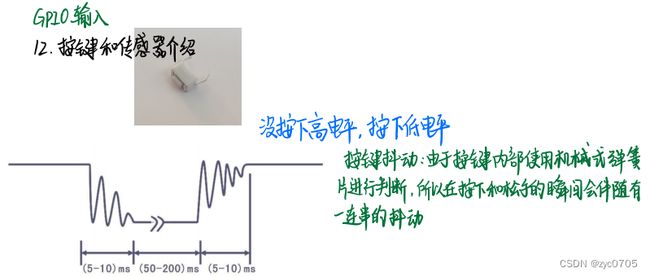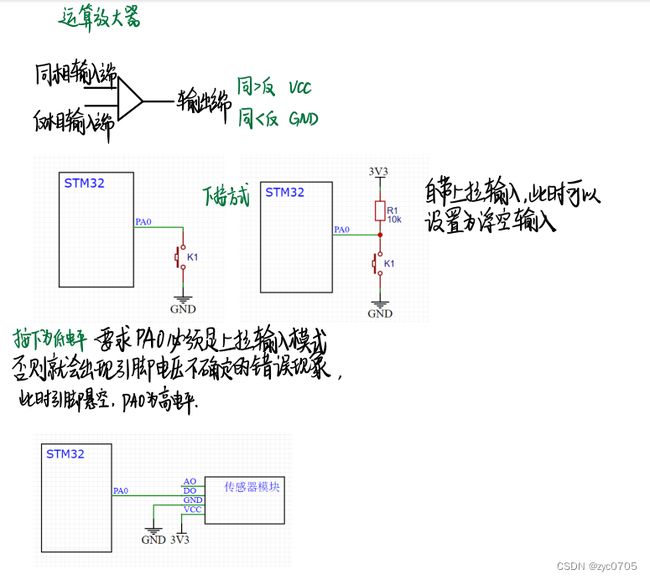stm32学习笔记:GPIO输入
1、寄存器输入输出函数
//读取输入数据寄存器某一个端口的输入值,参数用来指定某一个端口,返回值是
uint8_t类型,用来代表高低电平(读取按键的值)
uint8_t GPIO_ReadInputDataBit(GPIO_TypeDef* GPIOx, uint16_t GPIO_Pin);
//读取整个输入数据寄存器,参数用来指定外设,uint16_t是一个16位的数据,每一位代表一个端口值
uint16_t GPIO_ReadInputData(GPIO_TypeDef* GPIOx);
//读取输出寄存器
uint8_t GPIO_ReadOutputDataBit(GPIO_TypeDef* GPIOx, uint16_t GPIO_Pin);
//读取输出寄存器
uint16_t GPIO_ReadOutputData(GPIO_TypeDef* GPIOx);
ReadInput:读取GPIO口
ReadOutput:输出模式下输出的值/电平
2、按下按键:低电平
按键采取上拉输入模式,按下就接地,故没按下是高电平,按下的时候是低电平。
按键抖动 :由于按键内部使用机械式弹等片进行判新,所以在按下和松手的瞬间会伴随有一连串的抖动
GPIO_InitStructure.GPIO_Mode = GPIO_Mode_IPU;//上拉输入
上拉输入:可读取引脚电平,内部连接上拉电阻,悬空时默认高电平传感器元件的电阻会随看外界模拟量的变化而变化,通过领随电阻证即可得到模拟电压输出,再通过与电压比较器进行二值化即可得列数字电压输出
3、主要代码
(1)获取按键的值(按键接在B1和B11,led灯接在A1和A2)
//读取按键值的函数
uint8_t Key_GetNum(void)
{
uint8_t KeyNum = 0;
//读取GPIO端口的功能
if(GPIO_ReadInputDataBit(GPIOB, GPIO_Pin_1)==0) //按下
{
Delay_ms(20);
while((GPIO_ReadInputDataBit(GPIOB, GPIO_Pin_1)==0)); //检测按键松手
Delay_ms(20);
KeyNum = 1;
}
if(GPIO_ReadInputDataBit(GPIOB, GPIO_Pin_11)==0)
{
Delay_ms(20);
while((GPIO_ReadInputDataBit(GPIOB, GPIO_Pin_11)==0));
Delay_ms(20);
KeyNum = 2;
}
return KeyNum;
} (2)调用按键中的函数
while(1)
{
KeyNum = Key_GetNum();
if(KeyNum == 1)
{
LED1_ON();
}
if(KeyNum == 2)
{
LED1_OFF();
}
}4、全部代码:
一、按键控制灯
(1)key.c
#include "stm32f10x.h" // Device header
#include "Delay.h"
void Key_Init(void)
{
RCC_APB2PeriphClockCmd(RCC_APB2Periph_GPIOB,ENABLE);
GPIO_InitTypeDef GPIO_InitStructure;
GPIO_InitStructure.GPIO_Mode = GPIO_Mode_IPU;
GPIO_InitStructure.GPIO_Pin = GPIO_Pin_1 | GPIO_Pin_11;
GPIO_InitStructure.GPIO_Speed = GPIO_Speed_50MHz;
GPIO_Init(GPIOB,&GPIO_InitStructure);
}
//读取按键值的函数
uint8_t Key_GetNum(void)
{
uint8_t KeyNum = 0;
//读取GPIO端口的功能
if(GPIO_ReadInputDataBit(GPIOB, GPIO_Pin_1)==0) //按下
{
Delay_ms(20);
while((GPIO_ReadInputDataBit(GPIOB, GPIO_Pin_1)==0)); //检测按键松手
Delay_ms(20);
KeyNum = 1;
}
if(GPIO_ReadInputDataBit(GPIOB, GPIO_Pin_11)==0)
{
Delay_ms(20);
while((GPIO_ReadInputDataBit(GPIOB, GPIO_Pin_11)==0));
Delay_ms(20);
KeyNum = 2;
}
return KeyNum;
} (2)key.h
#ifndef __KEY_H
#define __KEY_H
void Key_Init(void);
uint8_t Key_GetNum(void);
#endif(3)led
#include "stm32f10x.h" // Device header 头文件
void LED_Init(void) //LED初始化函数
{
RCC_APB2PeriphClockCmd(RCC_APB2Periph_GPIOA,ENABLE);
GPIO_InitTypeDef GPIO_InitStructure; //配置端口模式
GPIO_InitStructure.GPIO_Mode = GPIO_Mode_Out_PP;
GPIO_InitStructure.GPIO_Pin = GPIO_Pin_1 | GPIO_Pin_2;
GPIO_InitStructure.GPIO_Speed = GPIO_Speed_50MHz;
GPIO_Init(GPIOA,&GPIO_InitStructure);
GPIO_SetBits(GPIOA, GPIO_Pin_1 | GPIO_Pin_2);//关闭LED
}
void LED1_ON(void) //控制LED开关灯
{
GPIO_ResetBits(GPIOA, GPIO_Pin_1);
}
void LED1_OFF(void)
{
GPIO_SetBits(GPIOA, GPIO_Pin_1);
}
void LED1_Turn(void)
{
if(GPIO_ReadOutputDataBit(GPIOA,GPIO_Pin_1)==0)
{
GPIO_SetBits(GPIOA,GPIO_Pin_1); //再按一下置为1
}
else
{
GPIO_ResetBits(GPIOA,GPIO_Pin_1);
}
}
void LED2_ON(void)
{
GPIO_ResetBits(GPIOA, GPIO_Pin_2);
}
void LED2_OFF(void)
{
GPIO_SetBits(GPIOA, GPIO_Pin_2);
}
void LED2_Turn(void)
{
if(GPIO_ReadOutputDataBit(GPIOA,GPIO_Pin_2)==0)
{
GPIO_SetBits(GPIOA,GPIO_Pin_2);
}
else
{
GPIO_ResetBits(GPIOA,GPIO_Pin_2);
}
}(4)led.h
#ifndef __LED_H
#define __LED_H
void LED_Init(void);
void LED1_ON(void);
void LED1_OFF(void);
void LED1_Turn(void);
void LED2_ON(void);
void LED2_OFF(void);
void LED2_Turn(void);
#endif(5)主函数
#include "stm32f10x.h" // Device header
#include "Delay.h"
#include "LED.h"
#include "Key.h"
uint8_t KeyNum; //存储键码的返回值
int main(void)
{
LED_Init();
Key_Init();
while(1)
{
KeyNum = Key_GetNum();
if(KeyNum == 1)
{
LED1_ON();
}
if(KeyNum == 2)
{
LED1_OFF();
}
}
}二、光敏传感器控制蜂鸣器
当遮住光线时,输出指示灯灭,代表输出高电平,有光线时,输出指示灯亮,代表输出低电平
(6)Buzzer.c
#include "stm32f10x.h" // Device header
void Buzzer_Init(void)
{
RCC_APB2PeriphClockCmd(RCC_APB2Periph_GPIOB, ENABLE);
GPIO_InitTypeDef GPIO_InitStructure;
GPIO_InitStructure.GPIO_Mode = GPIO_Mode_Out_PP;
GPIO_InitStructure.GPIO_Pin = GPIO_Pin_12;
GPIO_InitStructure.GPIO_Speed = GPIO_Speed_50MHz;
GPIO_Init(GPIOB, &GPIO_InitStructure);
GPIO_SetBits(GPIOB, GPIO_Pin_12);
}
void Buzzer_ON(void)
{
GPIO_ResetBits(GPIOB, GPIO_Pin_12);
}
void Buzzer_OFF(void)
{
GPIO_SetBits(GPIOB, GPIO_Pin_12);
}
void Buzzer_Turn(void)
{
if (GPIO_ReadOutputDataBit(GPIOB, GPIO_Pin_12) == 0)
{
GPIO_SetBits(GPIOB, GPIO_Pin_12);
}
else
{
GPIO_ResetBits(GPIOB, GPIO_Pin_12);
}
}(7)Buzzer.h
#ifndef __BUZZER_H
#define __BUZZER_H
void Buzzer_Init(void);
void Buzzer_ON(void);
void Buzzer_OFF(void);
void Buzzer_Turn(void);
#endif(8)LightSensor.c
#include "stm32f10x.h" // Device header
void LightSensor_Init(void)
{
RCC_APB2PeriphClockCmd(RCC_APB2Periph_GPIOB, ENABLE);
GPIO_InitTypeDef GPIO_InitStructure;
GPIO_InitStructure.GPIO_Mode = GPIO_Mode_IPU;//上拉模式
GPIO_InitStructure.GPIO_Pin = GPIO_Pin_13;
GPIO_InitStructure.GPIO_Speed = GPIO_Speed_50MHz;
GPIO_Init(GPIOB, &GPIO_InitStructure);
}
uint8_t LightSensor_Get(void)
{
return GPIO_ReadInputDataBit(GPIOB, GPIO_Pin_13);
}(9)LightSensor.h
#ifndef __LIGHT_SENSOR_H
#define __LIGHT_SENSOR_H
void LightSensor_Init(void);
uint8_t LightSensor_Get(void);
#endif
(10)主函数
#include "stm32f10x.h" // Device header
#include "Delay.h"
#include "Buzzer.h"
#include "LightSensor.h"
int main(void)
{
Buzzer_Init();
LightSensor_Init();
while (1)
{
if(LightSensor_Get()==1) //光线暗
{
Buzzer_ON();
}
else
{
Buzzer_OFF();
}
}
} 


